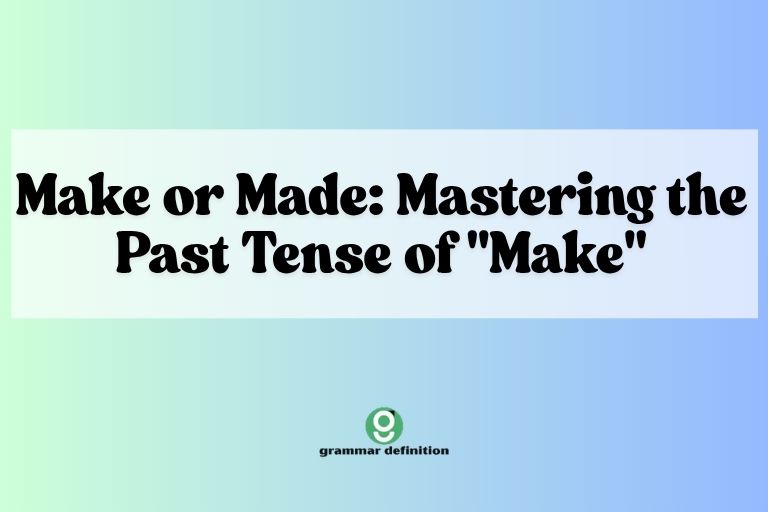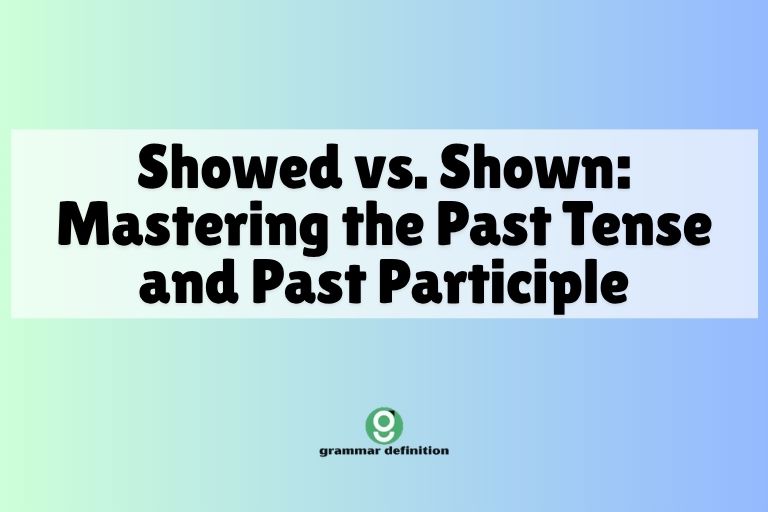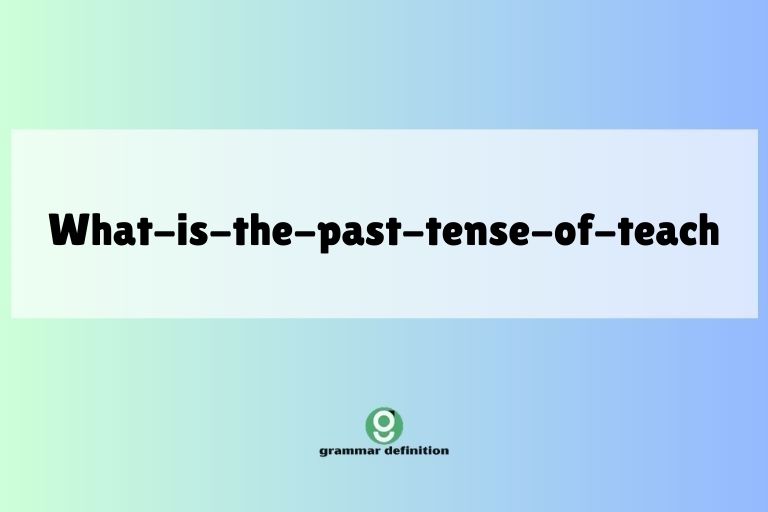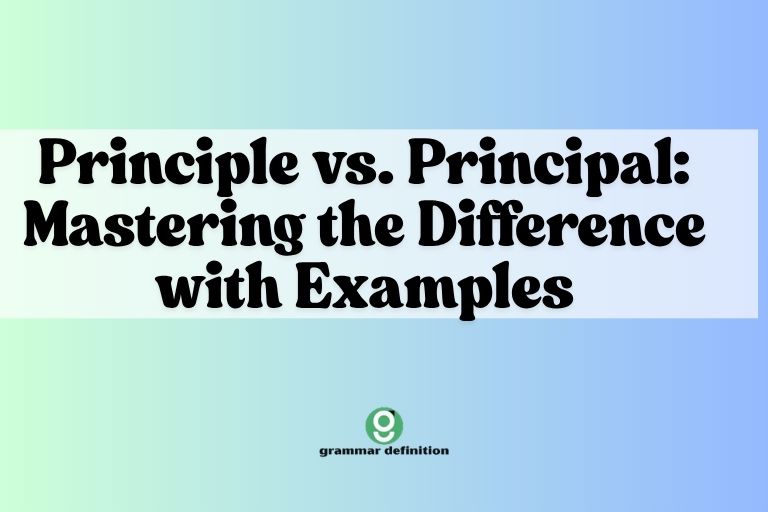Make or Made: Mastering the Past Tense of “Make”

Understanding the correct past tense of verbs is crucial for effective communication in English. The verb “make” is one of the most common verbs in the English language, and knowing its past tense, “made,” is essential for constructing grammatically correct sentences.
This article provides a comprehensive guide to the past tense of “make,” covering its definition, usage, common mistakes, and practice exercises to help you master this fundamental aspect of English grammar. Whether you’re a beginner or an advanced learner, this guide will provide valuable insights and practical exercises to improve your understanding and accuracy.
Table of Contents
- Introduction
- Definition of “Make” and “Made”
- Structural Breakdown
- Types of Usage
- Examples of “Made” in Sentences
- Usage Rules for “Made”
- Common Mistakes with “Make” and “Made”
- Practice Exercises
- Advanced Topics
- FAQ: Frequently Asked Questions
- Conclusion
Definition of “Make” and “Made”
The verb “make” is a versatile word with several meanings, generally related to creating, constructing, or causing something. It can refer to manufacturing a physical object, creating a plan, or causing someone to feel a certain way.
Understanding its various meanings is essential for using it correctly in different contexts.
Definition of “Make”
“Make” is a verb that means to create or construct something, to cause something to exist or happen, or to cause someone to be or do something. It is a base form verb and is used in the present tense and infinitive forms.
Definition of “Made”
“Made” is the past tense and past participle of the verb “make.” It indicates that an action of creating, constructing, or causing something happened in the past. It is used in simple past tense sentences and in perfect tenses.
Structural Breakdown
Understanding the grammatical structure of “make” and “made” in sentences is essential for correct usage. This section breaks down how these words function within different sentence structures.
Simple Past Tense
In the simple past tense, “made” is used to describe actions that were completed at a specific time in the past. The structure is typically: Subject + Made + Object/Complement.
Past Participle
“Made” also functions as the past participle of “make.” It is used in perfect tenses (present perfect, past perfect, future perfect) and in passive voice constructions. For perfect tenses, the structure is: Subject + Have/Had/Will Have + Made + Object/Complement. In passive voice, the structure is: Subject + Was/Were + Made + (By + Agent).
Examples of Structural Use
Consider these examples to illustrate the structural breakdown:
- Simple Past: She made a cake yesterday.
- Present Perfect: They have made significant progress.
- Past Perfect: He had made dinner before she arrived.
- Passive Voice: The dress was made by a famous designer.
Types of Usage
The verb “make” and its past tense “made” have a wide range of uses. Here are some common categories of usage with examples.
Creating or Constructing
“Make” and “made” are often used to describe the act of creating or constructing something tangible or intangible.
Causing Something to Happen
These words can also indicate causing something to occur or bringing about a certain result.
Expressing Obligation or Necessity
In some contexts, “make” and “made” can express that someone is obligated or forced to do something.
Making Decisions or Plans
They can also be used when discussing decisions, plans, or arrangements.
Expressing Feelings or Reactions
“Make” and “made” can describe how someone causes another person to feel.
Examples of “Made” in Sentences
To further illustrate the usage of “made,” here are several examples categorized by different contexts. Each table provides a variety of sentences to showcase the versatility of “made.”
Table 1: Creating or Constructing
This table illustrates the use of “made” in the context of creating or constructing something, whether it’s a physical object, a piece of art, or a culinary creation. These examples showcase the action of bringing something into existence through effort or skill.
| Example Sentence | Context |
|---|---|
| She made a beautiful dress for the party. | Fashion |
| He made a model airplane from scratch. | Hobbies |
| They made a delicious cake for the celebration. | Cooking |
| The artist made a stunning sculpture out of clay. | Art |
| The carpenter made a sturdy table and chairs. | Craftsmanship |
| She made a quilt for her grandchild. | Handicraft |
| He made a website for his small business. | Technology |
| They made a movie about their adventures. | Filmmaking |
| The chef made a new dish with unique ingredients. | Culinary Arts |
| The engineer made a prototype of the new invention. | Engineering |
| She made a scrapbook filled with memories. | Hobbies |
| He made a snowman in the front yard. | Winter Activities |
| They made a fort out of blankets and pillows. | Childhood Games |
| The architect made a blueprint for the building. | Architecture |
| The writer made a compelling story. | Literature |
| She made a presentation for the conference. | Business |
| He made a garden in his backyard. | Gardening |
| They made a documentary about wildlife. | Filmmaking |
| The composer made a beautiful symphony. | Music |
| The programmer made an app for the smartphone. | Technology |
| She made a mask for the costume party. | Crafts |
| He made a birdhouse for the garden. | Hobbies |
| They made a pizza from scratch. | Cooking |
| The potter made a vase on the wheel. | Ceramics |
| She made a drawing in her sketchbook. | Art |
| He made a sculpture out of metal. | Sculpting |
| They made a robot for the science fair. | Science |
Table 2: Causing Something to Happen
This table focuses on how “made” is used to describe causing an event, situation, or feeling. These examples illustrate how actions can lead to specific outcomes or influence the state of affairs.
| Example Sentence | Context |
|---|---|
| The rain made the plants grow faster. | Nature |
| His speech made everyone feel inspired. | Emotions |
| The news made her very sad. | Reactions |
| The loud noise made the baby cry. | Effects |
| The warm weather made the ice melt. | Climate |
| Her kindness made a big difference in his life. | Impact |
| The pressure made him nervous. | Feelings |
| The challenge made them stronger. | Growth |
| The mistake made them more cautious. | Lessons Learned |
| The opportunity made her hopeful. | Optimism |
| The delay made us late for the meeting. | Time Management |
| The joke made everyone laugh. | Humor |
| The exercise made him feel energized. | Health |
| The sunshine made the day brighter. | Weather |
| The accident made him more careful. | Safety |
| The surprise made her speechless. | Reactions |
| The music made them want to dance. | Entertainment |
| The long journey made us tired. | Travel |
| The good news made her happy. | Emotions |
| The competition made them work harder. | Motivation |
| The argument made them angry. | Conflict |
| The compliment made him blush. | Reactions |
| The movie made her cry. | Entertainment |
| The story made them think. | Intellectual Stimulation |
| The encouragement made him feel confident. | Support |
| The challenge made her determined. | Motivation |
| The victory made them celebrate. | Achievements |
Table 3: Expressing Obligation or Necessity
This table demonstrates how “made” is utilized to convey a sense of obligation or necessity. The examples show situations where someone is compelled or required to take a certain action, often due to external forces or circumstances.
| Example Sentence | Context |
|---|---|
| The contract made him sign a confidentiality agreement. | Legal |
| The rules made them wear uniforms. | Regulations |
| The circumstances made her quit her job. | Situational |
| His promise made him keep his word. | Commitment |
| The law made them pay taxes. | Government |
| The pressure made her work overtime. | Workplace |
| The tradition made them celebrate the holiday. | Culture |
| The emergency made him call for help. | Urgency |
| The debt made them sell their house. | Financial |
| The agreement made her collaborate with the team. | Teamwork |
| The schedule made him wake up early. | Routine |
| The responsibility made her take charge. | Leadership |
| The request made him reconsider his decision. | Consideration |
| The demand made her increase production. | Business |
| The requirement made them complete the training. | Education |
| The situation made him apologize. | Social |
| The threat made her comply with the demands. | Pressure |
| The need made him ask for assistance. | Support |
| The challenge made her prove herself. | Motivation |
| The opportunity made them seize the moment. | Chance |
| The deadline made him rush the project. | Time Management |
| The invitation made her attend the event. | Social |
| The promise made him keep his secret. | Loyalty |
| The order made them follow instructions. | Authority |
| The concern made her check on him. | Care |
| The warning made him take precautions. | Safety |
| The offer made them accept the deal. | Negotiation |
Table 4: Making Decisions or Plans
This table illustrates the usage of “made” when discussing decisions, plans, or arrangements. The examples show how “made” can be used to indicate the act of deciding, planning, or organizing events and activities.
| Example Sentence | Context |
|---|---|
| They made a decision to move to a new city. | Relocation |
| She made plans to travel to Europe next summer. | Travel |
| He made arrangements for the party. | Events |
| We made a reservation at the restaurant. | Dining |
| They made a commitment to support the charity. | Philanthropy |
| She made a proposal for the new project. | Business |
| He made a suggestion to improve the process. | Efficiency |
| They made a deal to collaborate on the venture. | Partnership |
| She made a promise to help her friend. | Friendship |
| He made a list of things to do. | Organization |
| They made a schedule for the week. | Planning |
| She made a budget for the trip. | Finance |
| He made a compromise to resolve the conflict. | Negotiation |
| They made a choice to pursue their dreams. | Aspiration |
| She made a strategy for the competition. | Competition |
| He made a resolution to exercise more. | Health |
| They made a discovery that changed everything. | Innovation |
| She made a statement to clarify her position. | Communication |
| He made a contribution to the community. | Social |
| They made a breakthrough in their research. | Science |
| She made a forecast for the upcoming year. | Prediction |
| He made a survey to gather feedback. | Research |
| They made a system to manage their tasks. | Productivity |
| She made a timeline for the project. | Project Management |
| He made a report on the findings. | Documentation |
| They made a presentation of their work. | Communication |
| She made a review of the book. | Criticism |
Usage Rules for “Made”
To use “made” correctly, it’s important to understand the specific rules that govern its usage in different contexts. Here are some key rules and guidelines.
Rule 1: Simple Past Tense
“Made” is the standard form for the simple past tense of “make.” It should be used to describe actions completed in the past.
Rule 2: Perfect Tenses
“Made” is also the past participle of “make” and is used in perfect tenses such as present perfect, past perfect, and future perfect.
Rule 3: Passive Voice
In passive voice constructions, “made” is used with a form of the verb “be” (was/were) to indicate that the subject of the sentence received the action.
Rule 4: Common Expressions and Idioms
There are several common expressions and idioms that use “made.” It’s important to learn these phrases as they often have specific meanings.
Rule 5: Avoid Using “Make” in the Past Tense
The most common mistake is using “make” instead of “made” when referring to past actions. Always remember that “made” is the correct past tense form.
Common Mistakes with “Make” and “Made”
One of the most frequent errors in English grammar is using the incorrect form of “make” in the past tense. Here are some common mistakes and their corrections.
Mistake 1: Using “Make” Instead of “Made”
Incorrect: Yesterday, I make a cake.
Correct: Yesterday, I made a cake.
Mistake 2: Incorrect Use in Perfect Tenses
Incorrect: They have make a lot of progress.
Correct: They have made a lot of progress.
Mistake 3: Misuse in Passive Voice
Incorrect: The toy was make in China.
Correct: The toy was made in China.
Table 5: Correct vs. Incorrect Examples
This table provides a clear comparison between incorrect and correct uses of “make” and “made” in various sentence structures. It highlights common errors and demonstrates the proper application of the past tense form.
| Incorrect | Correct | Explanation |
|---|---|---|
| I make dinner last night. | I made dinner last night. | “Made” is the past tense of “make.” |
| She have make a mistake. | She has made a mistake. | Use “made” as the past participle with “has/have.” |
| The house was make by them. | The house was made by them. | “Made” is the correct form in passive voice. |
| He didn’t make his bed this morning. | He didn’t make his bed this morning. | Correct use in a negative sentence. |
| We are going to make a pizza. | We are going to make a pizza. | Correct use of “make” in the future tense. |
| They should make an effort. | They should make an effort. | Correct use in a modal verb construction. |
| I’m going to make sure everything is ready. | I’m going to make sure everything is ready. | Correct use of “make sure.” |
| She make a promise to help. | She made a promise to help. | “Made” is necessary to show past tense. |
| They had make a plan before. | They had made a plan before. | Use “made” as the past participle with “had.” |
| He will make a speech tomorrow. | He will make a speech tomorrow. | Correct use in the future tense. |
| I make a new friend at the party. | I made a new friend at the party. | “Made” indicates the action happened in the past. |
| They have make a big decision. | They have made a big decision. | “Made” is the past participle needed. |
| The cake was make for the party. | The cake was made for the party. | Passive voice requires “made.” |
| She didn’t made any mistakes. | She didn’t make any mistakes. | “Make” is correct after “didn’t.” |
| We will made a presentation next week. | We will make a presentation next week. | “Make” is correct with “will.” |
| They should made an appointment. | They should make an appointment. | “Make” is used with modal verbs like “should.” |
| I’m going to made a reservation. | I’m going to make a reservation. | “Make” follows “going to.” |
| She make a phone call yesterday. | She made a phone call yesterday. | “Made” is the past tense form. |
| They had make arrangements. | They had made arrangements. | “Made” is the past participle for perfect tenses. |
| He will made a difference. | He will make a difference. | “Make” is used with “will” for future tense. |
| I make a promise. | I made a promise. | “Made” is the past tense form. |
Practice Exercises
Test your understanding of “made” with these practice exercises. Each exercise focuses on different aspects of usage, from simple past tense to perfect tenses and passive voice.
Answers are provided at the end of each exercise.
Exercise 1: Simple Past Tense
Fill in the blanks with the correct form of the verb “make” (made).
| Question | Answer |
|---|---|
| 1. Yesterday, I ______ a delicious sandwich. | made |
| 2. She ______ a beautiful painting for her friend. | made |
| 3. The carpenter ______ a sturdy chair. | made |
| 4. They ______ a lot of noise last night. | made |
| 5. He ______ a mistake on the test. | made |
| 6. We ______ a reservation at the restaurant. | made |
| 7. The chef ______ a new dish for the menu. | made |
| 8. She ______ a difficult decision. | made |
| 9. He ______ an effort to improve his grades. | made |
| 10. They ______ a discovery in the lab. | made |
Exercise 2: Perfect Tenses
Complete the sentences using the present perfect or past perfect tense of “make.”
| Question | Answer |
|---|---|
| 1. I ______ (make) a lot of progress in my studies. | have made |
| 2. She ______ (make) several new friends since she moved here. | has made |
| 3. They ______ (make) a significant contribution to the project. | have made |
| 4. He ______ (make) sure to lock the door before leaving. | had made |
| 5. We ______ (make) all the necessary arrangements for the trip. | had made |
| 6. The team ______ (make) a breakthrough in their research. | has made |
| 7. She ______ (make) a name for herself in the industry. | has made |
| 8. He ______ (make) a promise that he intended to keep. | had made |
| 9. They ______ (make) it clear that they were not interested. | had made |
| 10. I ______ (make) a mental note to call her later. | have made |
Exercise 3: Passive Voice
Rewrite the following sentences in the passive voice using “made.”
| Question | Answer |
|---|---|
| 1. The chef made the cake. | The cake was made by the chef. |
| 2. The company manufactured the cars in Detroit. | The cars were made in Detroit by the company. |
| 3. The artist created the sculpture. | The sculpture was made by the artist. |
| 4. They built the house last year. | The house was made last year. |
| 5. The students prepared the presentation. | The presentation was made by the students. |
| 6. A famous designer created the dress. | The dress was made by a famous designer. |
| 7. The workers constructed the bridge. | The bridge was made by the workers. |
| 8. The children made the snowman. | The snowman was made by the children. |
| 9. The team developed the software. | The software was made by the team. |
| 10. The author wrote the book. | The book was made by the author. |
Advanced Topics
For advanced learners, understanding the nuances and idiomatic uses of “make” and “made” can further enhance their command of the English language. This section explores some advanced topics related to these verbs.
Idiomatic Expressions with “Make” and “Made”
English is rich with idiomatic expressions that use “make” and “made.” These expressions often have meanings that are not immediately obvious from the individual words.
Phrasal Verbs with “Make”
Phrasal verbs combine “make” with a preposition or adverb to create new meanings. Understanding these phrasal verbs is essential for advanced English proficiency.
Subjunctive Mood
In certain formal contexts, “make” can be used in the subjunctive mood, expressing a wish, suggestion, or requirement.
FAQ: Frequently Asked Questions
Here are some frequently asked questions about the usage of “make” and “made,” along with detailed answers to help clarify any confusion.
- Q: What is the difference between “make” and “made”?
A: “Make” is the base form of the verb, used in the present tense and infinitive forms. “Made” is the past tense and past participle of “make,” used to describe actions completed in the past and in perfect tenses. - Q: How do I use “made” in a sentence?
A: “Made” is used in the simple past tense to describe actions that happened in the past (e.g., “She made a cake yesterday.”) and as a past participle in perfect tenses (e.g., “They have made significant progress.”) and passive voice constructions (e.g., “The dress was made by a famous designer.”). - Q: Can you give an example of “made” in the present perfect tense?
A: Yes, an example is: “I have made several important decisions this year.” In this sentence, “have made” indicates an action completed at an unspecified time in the past that is relevant to the present. - Q: How is “made” used in the passive voice?
A: In the passive voice, “made” is used with a form of the verb “be” (was/were) to indicate that the subject of the sentence received the action. For example: “The film was made in Hollywood.” - Q: What are some common mistakes to avoid when using “made”?
A: Common mistakes include using “make” instead of “made” when referring to past actions (e.g., saying “I make dinner last night” instead of “I made dinner last night”) and using the incorrect form in perfect tenses (e.g., saying “They have make progress” instead of “They have made progress”). - Q: Are there any idiomatic expressions that use “made”?
A: Yes, there are many idiomatic expressions such as “made of,” “made up,” “made for,” and “made from.” For example, “He is made of strong stuff” means he is resilient and tough. - Q: What is the difference between “make” and “do”?
A: “Make” typically involves creating or constructing something, while “do” is used for actions, tasks, or general activities. For example, you “make a cake” but “do your homework.” - Q: How do I use “made” in negative sentences?
A: In negative sentences, use “didn’t make” to indicate that an action did not happen in the past. For example, “I didn’t make any mistakes on the test.”
Conclusion
Mastering the past tense of “make” is crucial for accurate and effective communication in English. “Made” is the correct past tense and past participle form, essential for constructing grammatically sound sentences in various contexts, including simple past tense, perfect tenses, and passive voice.
By understanding the definitions, usage rules, and common mistakes associated with “make” and “made,” you can significantly improve your English grammar skills. Remember to practice regularly and pay attention to the context in which you are using these verbs.






